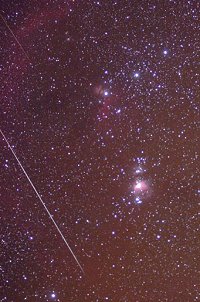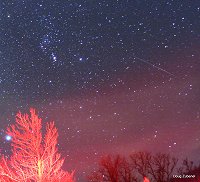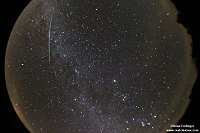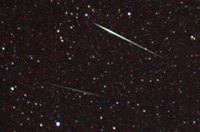| |
| |
Photographer,
Location |
Images |
Comments |
|

|
Amir H. Abolfath,
Abyaneh, Isfahan, Iran
Dec. 14, 2009 |
#1,
#2,
#3,
more |
Last night was wonderful. Many meteors passed upon us and I had chance to capture some of them.
|
|

|
Doug Zubenel,
40 miles west of Topeka, Kansas, one half mile south of Interstate 70 in Riley County, Kansas.
Dec. 13, 2009 |
#1,
#2 |
After taking a long, careful look at the late-afternoon satellite loop for Kansas, I decided my best - but slim - chance for a clear sky would be to get out into the central part of the state. At about 9:00 pm, CST, I stepped out of my car for a minute at a dark crossroad about 5 miles north of Abilene. I saw one first magnitude Geminid flash past Capella in Auriga. Only about 20 percent of the sky was clear, and clouds were rushing from the SW, so I headed east and south. Passing through Junction City at 10:19 pm, I saw a Geminid through the clouds near Mars that was at least as bright as the planet. I caught up to a rather large patch of reasonably clear sky at 10:40pm, and got off the highway at mile marker 316, and found a nice deserted road along the edge of which I set up and started shooting. A strong breeze had picked up, hissing through the branches of an Oak tree still clinging to its dead leaves, and Coyotes were howling off to the west. Geminids were dropping like diamonds, and between 10:40 and 11:20 pm I saw a dozen - all in the south. This 40 second exposure was made at 11:03 pm.
|
|

|
Andy Smith,
Devon, UK.
Dec. 14, 2009 |
#1,
#2,
more |
Geminid meteor shower data and spectrogram plots of the hourly meteor rate as recorded by Andy Smith, G7IZU, in Devon, United Kingdom. The rate was sampled at 10 minute intervals using two receivers tuned to transmitters in Portugal on 48.2422 MHz and 55.250 MHz. The short spike in the rate at around 17h on Dec 13th was caused by sporadic-E. The spectrogram shows one hour of echos during the peak hour.
|
|

|
Brian Emfinger,
Ozark, Arkansas, USA
Dec. 14, 2009 |
#1,
#2,
#3,
#4,
more |
Low clouds and
fog made viewing impossible at home so I drove up to Mount
Magazine State Park (Arkansas' highest point) which was
high enough to be above the low clouds and fog. I managed
to catch 26 Geminid Meteors with my camera.
Photo
details: Canon
500D/T1I, ISO 3200, F3.5, 60-90 sec exposures. |
|

|
Xin Li,
Huailai,Hebei,China
Dec. 14, 2009 |
#1,
#2,
more |
There were more
than three teams from Beijing Planetarium, went around Beijing
for Geminids several station observation.I took the pictures
Huailai,north-west of Beijing.
Photo
details: Canon
EOS 40D,17mm, F/4.0, iso 3200, 60s exposure. |
more images:
from
Mark Wloch of Southgate, MI; from
Jason Evans of Eastleigh, Hampshire, UK;
|
|